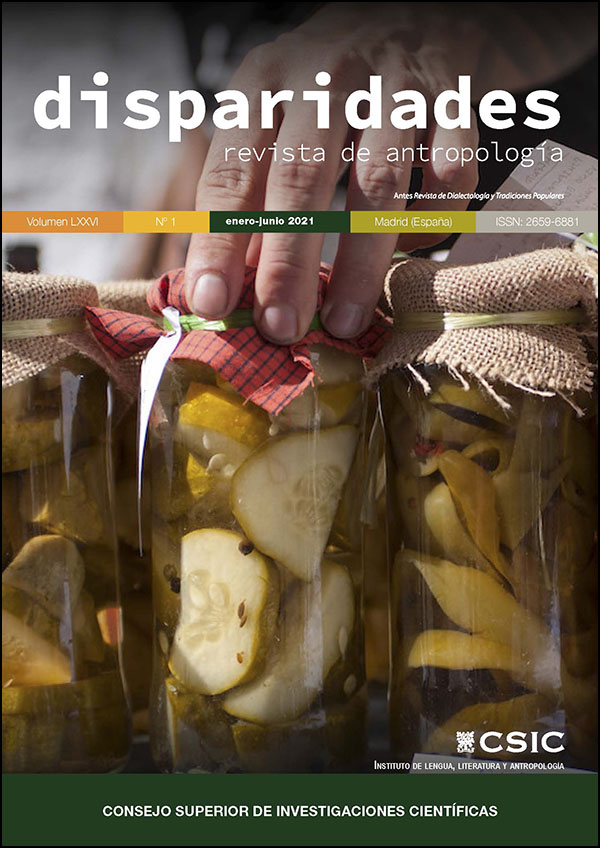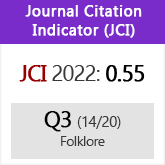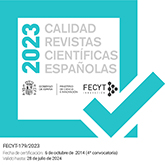Escuchar a los objetos
DOI:
https://doi.org/10.3989/dra.2021.005Palabras clave:
Narrativa, Materialidad, Objeto, Relatos, Vida cotidiana, IntimidadResumen
Esta sección experimental incluye algunas partes del evento performativo “La materialidad de las transformaciones: escuchar a los objetos”, que clausuró el XIV congreso de SIEF celebrado en Santiago de Compostela en 2019. Barbara Kirshenblatt-Gimblett, Regina Bendix, Dorothy Noyes, Sharon Roseman y Francisco Cruces conversaron sobre los significados culturales de una selección de objetos personales. Al desvelar las historias contenidas en mezuzahs, cabello, una fuente o un chal, se puso a prueba el poder metodológico del par objeto / historia, los beneficios de articular la narratividad con la materialidad y el silencioso poder de las cosas en la vida cotidiana. Se destacó el carácter incorporado de la narración y algunas de sus virtudes afectivas, morales y celebratorias. Este evento performativo se puede ver en <https://vimeo.com/362078953> from minute 00:52:50 to 01:31:00.
Descargas
Citas
Appadurai, Arjun (ed.). 1988. The Social Life of Things. Cambridge: Cambridge University Press.
Bernhardt, Austin. 2017.The Pros and Cons of Mentioning Dead-People Hair in Your Wig Ad. (posted March). <http://www.cc.com/news/2437/the-pros-and-cons-of-mentioning-dead-people-hair-in-your-wig-ad/ > (checked April 5, 2019).
Kolnberger, Thomas. 2018. "Zwischen Mensch und Ding" in Hans Peter Hahn and Friedemann Neumann (eds.). Dinge als Herausforderung: 327-348. Bielefeld: transcript https://doi.org/10.14361/9783839445136-017
Lutz, Deborah. 2015. Relics of Death in Victorian Literature and Culture. Cambridge: Cambridge University Press. https://doi.org/10.1017/CBO9781139924887
Romanowski, Perry. n.d. "Are Hair Extensions Made from Human Corpses?" Episode 29 of The Beauty Brainshttp://thebeautybrains.com/2014/05/are-hair-extensions-made-from-human-corpses-the-beauty-brains-show-episode-29/ (checked April 5, 2019).
Thompson, Michael. 1979. Rubbish Theory. The Creation and Destruction of Value. Oxford: Oxford University Press.
Tiedemann, Nicole. 2007. Haar-Kunst: zur Geschichte und Bedeutung eines menschlichen Schmuckstücks. Köln: Böhlau.
Varda, Agnès. 2000. Les glaneurs et la glaneuse. Film. New York: Zeitgeist Films.
Windmüller, Sonja. 2004. Die Kehrseite der Dinge. Müll, Abfall, Wegwerfen als kulturwissenschaftliches Problem. Berlin: Lit Verlag.
Wöhlke, Sabine. 2015. Geschenkte Organe: ethische und kulturelle Herausforderungen bei der familiären Lebendnierenspende. Frankfurt a.M.: Campus Verlag.
Baltzell, E. Digby. 1964. The Protestant establishment. Aristocracy and caste in America. New York: Random House.
Thompson, Michael. 1979. Rubbish theory. The creation and destruction of value. Oxford: Oxford University Press.
A naye tkhine haskores neshomes. 1908. Naftali Zeiligold (pub.).
Altshuler [or Altshul], Moses ben Henoch Yerushalmi. 1596. Brantshpigl.
Baumel-Schwartz, Judy Tydor. 2017. "My grandmother's tkhine: Immigrant Jewish women's lives, identities and prayers in early twentieth-century America". NASHIM 31: 146-168. https://doi.org/10.2979/nashim.31.1.07
Breton, André. 1960[1928]. Nadja. Paris: Gallimard.
Brown, Sass. 2013. Refashioned. Cutting-edge clothing from upcycled materials. London: Laurence King Publishing.
Camic, Paul M., Julie Brooker and Anna Neal. 2011. "Found objects in clinical practice: Preliminary evidence". The Arts in Psychotherapy 38: 151-159. https://doi.org/10.1016/j.aip.2011.04.002
Castro, Rosalía de. 1863. Cantares gallegos. Vigo: Juan Compañel.
García Turnes, Beatriz. 2004. A lingua galega entre 1875 et 1916: situación social e consciencia idiomática. Pontevedra: Deputación Provincial de Pontevedra e Consellería de Educación e Ordenación Universitaria.
Jaspers, Jürgen. 2017. "Diglossia and beyond". In Ofelia García, Nelson Flores, and Massimiliano Spotti (eds.), The Oxford Handbook of Language and Society. Oxford: Oxford University Press. https://doi.org/10.1093/oxfordhb/9780190212896.013.27
Kay, Devra. 2004. Seyder tkhines: The forgotten Book of Common Prayer for Jewish women. Philadelphia: The Jewish Publication Society.
Kirshenblatt-Gimlett, Barbara. 2001. "Kitchen Judaism". In Susan L. Braunstein and Jenna Weissma Joselit (eds.), Getting comfortable in New York: The American Jewish home, 1880-1950: 77-105, New York: The Jewish Museum.
La Voz de Galicia. 2017. "O Santiaguiño recupera los trabajos del lino en Zas." 25/04/2017. Accessed on April 16, 2019. <https://www.lavozdegalicia.es/noticia/carballo/zas/2017/04/25/santiaguino-recupera-siembra-lino-zas/0003_201704C25C11994.htm>
Lantis, Margaret. 1960. "Vernacular culture". American Anthropologist 62: 202-216. https://doi.org/10.1525/aa.1960.62.2.02a00020
Marrelli, Nancy. 2006. "My favourite Montreal book..." Montreal Review of Books Winter issue. Accessed February 2, 2020. <https://mtlreviewofbooks.ca/reviews/the-brides-book-a-perpetual-guide-for-the-montreal-bride/>.
Margolis, Rebecca. 2011. Jewish roots, Canadian soil: Yiddish cultural life in Montreal, 1905-1945. Montreal and Kingston: McGill-Queen's University Press.
Mileaf, Janine. 2010. Please touch: Dada & Surrealist objects after the readymade. Hanover: Dartmouth College Press.
Molina, César Antonio. 1989. Prensa literaria en Galicia (1809-1920). Vigo: Edicións Xerais de Galicia.
Myerhoff, Barbara. 1980. Number our days. New York: Touchstone.
Nusche, Jan. 2002. "Lying in." CMAJ 167(6): 675-676. Accessed on February 2, 2020. <https://www.cmaj.ca/content/167/6/675>
Prendergast, Monica. 2012. "Education and/as art: A found poetry suite." International Journal of Education & the Arts 3(Interlude 2): 1-18.
Ramos-González, Alicia. 2005. "Daughters of tradition: Women in Yiddish culture in the 16th-18th centuries". European Journal of Women's Studies 12(2): 213-226. https://doi.org/10.1177/1350506805051243
Reed, Adam. 2006. "Documents unfolding", in Annelise Rise (ed.), Documents: Artifacts of modern knowledge: 158-167. Ann Arbor: University of Michigan Press.
Roseman, Sharon R. 1995. "'Falamos como falamos': Linguistic revitalization and the maintenance of local vernaculars in Galicia. Journal of Linguistic Anthropology 5(1): 3-32. https://doi.org/10.1525/jlin.1995.5.1.3
Roseman, Sharon R. 1997. "Lenguas de solidaridad en el medio rural: El mantenimiento del gallego vernáculo". In Xaquín Rodríguez Campos (ed.), As linguas e as identidades: Ensaios de etnografía e de interpretación antropolóxica, 105-22, Santiago de Compostela: Santiago de Compostela University Press.
Roseman, Sharon R. 2008. O Santiaguiño de Carreira: O rexurdimento dunha base rural no concelllo de Zas. A Coruña: Baía Edicións.
Shandler, Jeffrey. 2006. Adventures in Yiddishland: Postvernacular language & culture. Berkeley: University of California Press. Digital version. https://doi.org/10.1525/9780520931770 PMid:15780547
Steer, Linda. 2017. Appropriated photographs in French Surrealist periodicals, 1924-1939. London and New York: Routledge.
The Bride's Book. A Perpetual Guide for the Montreal Bride (n.d.) Montreal: Brandow Publishing.
von Rohden, Frauke. 2008. "Notes". In Rivkah bat Meir, Meneket Rivkah: A manual of wisdom and piety for Jewish women. Philadelphia: The Jewish Publication Society.
Weinreich, Uriel. 1977 [1968]. Modern English-Yiddish/Yiddish-English dictionary. New York: YIVO Institute for Jewish Research, Schocken Books.
Weissler, Chava. 1991. "Woman as high priest: a Kabbalistic prayer in Yiddish for lighting Sabbath candles". Jewish History 5(1): 9-26. https://doi.org/10.1007/BF01679790
Weissler, Chava. 1998. Voices of the matriarchs: Listening to the prayers of the Early Modern Jewish women. Boston: Beacon Press.
Weissler, Chava. "Tkhines". Jewish Women: A Comprehensive Historical Encyclopedia. 20 March 2019. Jewish Women's Archive (Accesed on March 28, 2019) .
Brumann, Christoff. 2014. "Heritage agnosticism: a third path for the study of cultural heritage." Social Anthropology/Anthropologie Sociale 22(2): 173-188. https://doi.org/10.1111/1469-8676.12068
Connerton, Paul. 2009. How Modernity Forgets. Cambridge: Cambridge University Press. https://doi.org/10.1017/CBO9780511627187
Cruces, Francisco and Jorge Moreno Andrés. 2018. The Order I Live In. An Indoor Urban Symphony. Documentary; 63 min. Available at Canal UNED: ˂https://canal.uned.es/video/5c07ac67b1111f5b718bb727˃. Accessed: 27 April. 2020.
Holquist, Michael. 1990. Dialogism. Bakhtin and His World. London and New York: Routledge. https://doi.org/10.4324/9780203330340
Löfgren, Orvar. 2014. "The Black Box of Everyday Life. Entanglements of Stuff, Affects and Activities". Cultural Analysis 13: 77-98.
Oliver, Mary. [1978] 2014. "In Blackwater Woods", from American Primitive. As quoted in Museum of Broken Relationships. A Diary. Zagreb: Museum of Broken Relationships, p. 9.
Publicado
Cómo citar
Número
Sección
Licencia
Derechos de autor 2021 Consejo Superior de Investigaciones Científicas (CSIC)

Esta obra está bajo una licencia internacional Creative Commons Atribución 4.0.
© CSIC. Los originales publicados en las ediciones impresa y electrónica de esta Revista son propiedad del Consejo Superior de Investigaciones Científicas, siendo necesario citar la procedencia en cualquier reproducción parcial o total.Salvo indicación contraria, todos los contenidos de la edición electrónica se distribuyen bajo una licencia de uso y distribución “Creative Commons Reconocimiento 4.0 Internacional ” (CC BY 4.0). Puede consultar desde aquí la versión informativa y el texto legal de la licencia. Esta circunstancia ha de hacerse constar expresamente de esta forma cuando sea necesario.
No se autoriza el depósito en repositorios, páginas web personales o similares de cualquier otra versión distinta a la publicada por el editor.
















